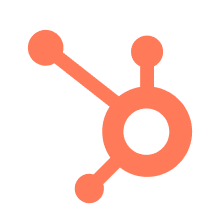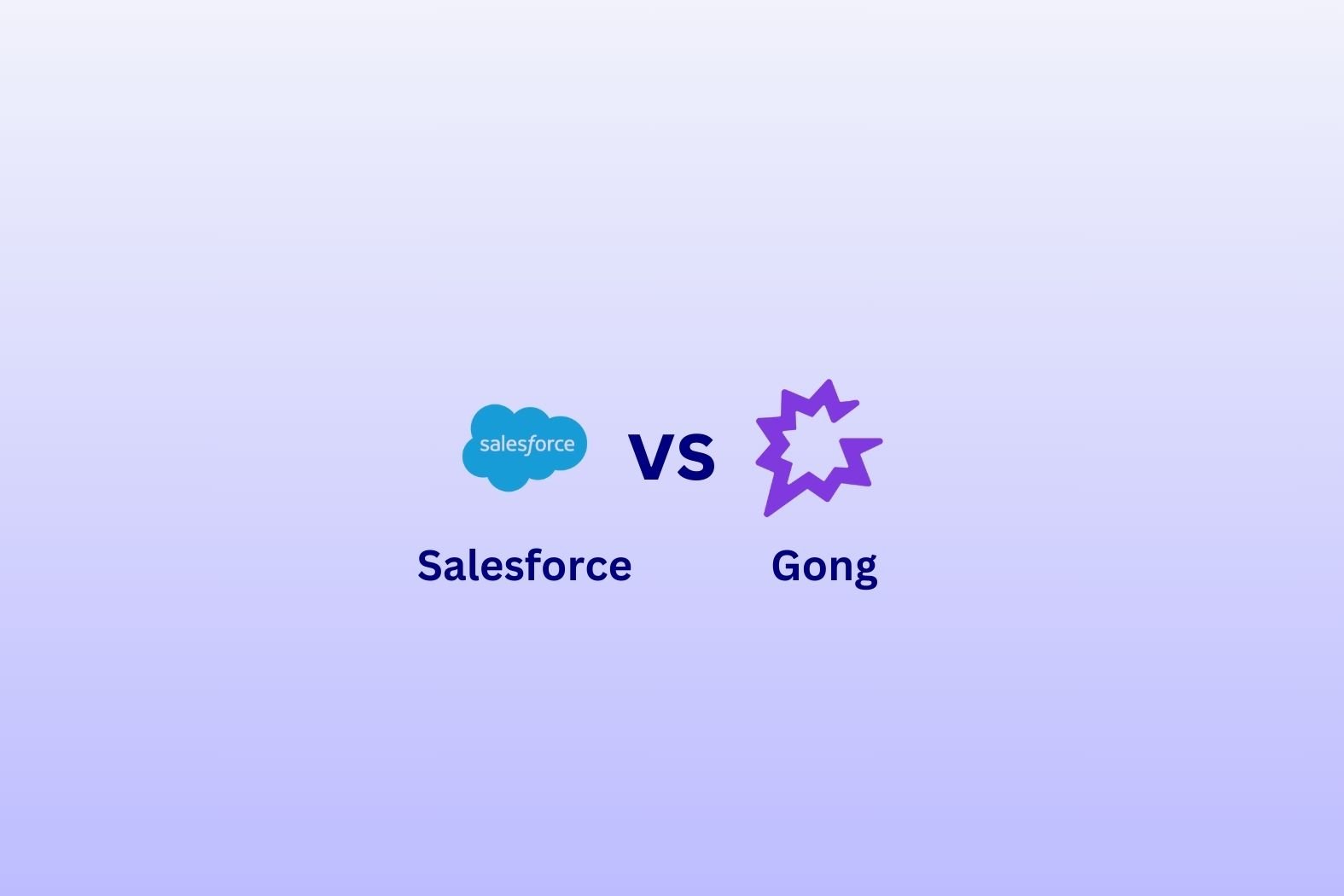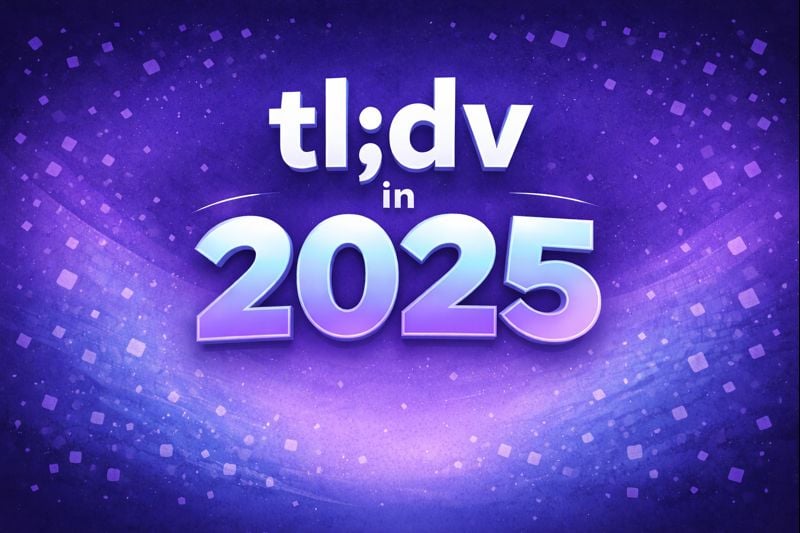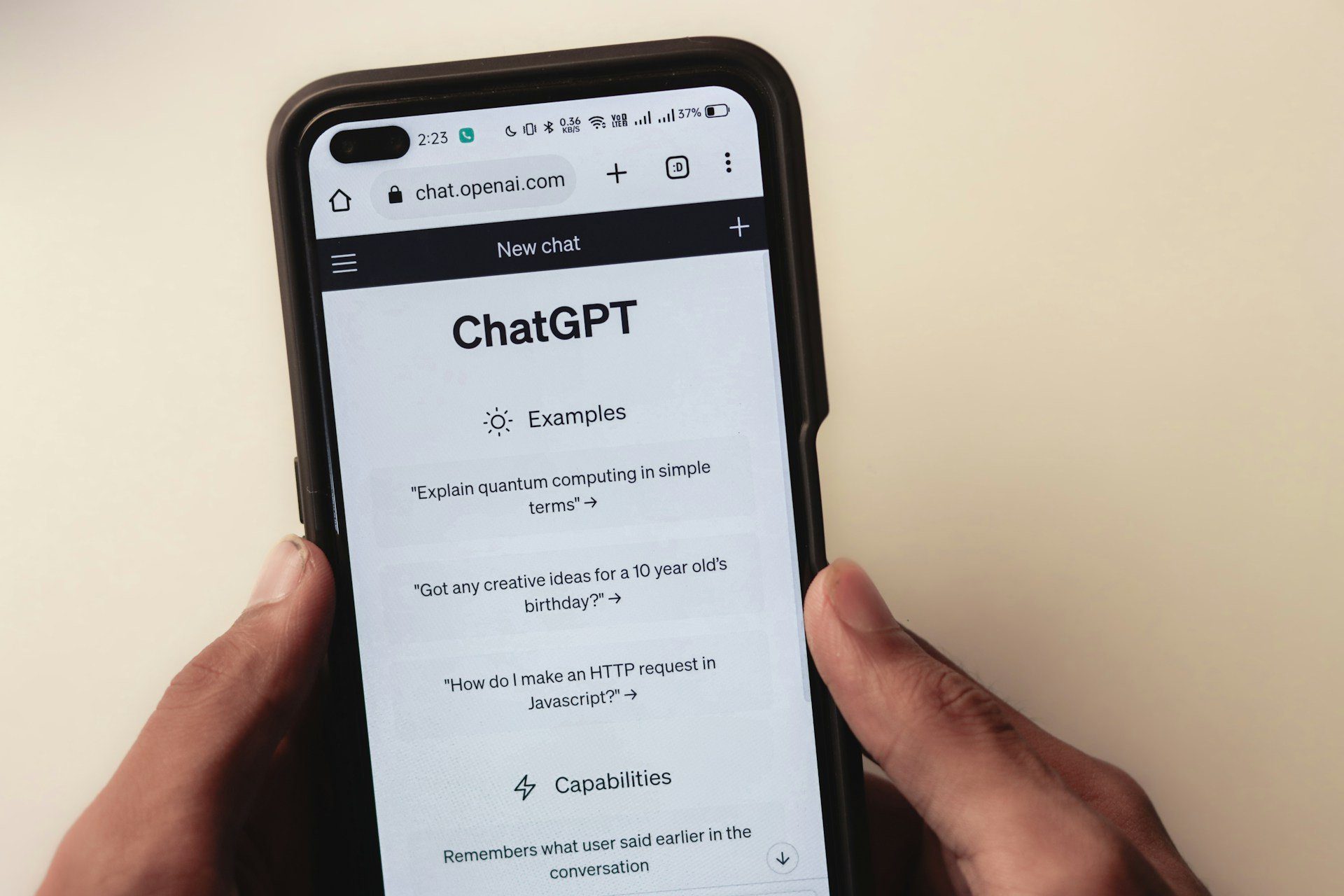In this Gong vs Salesforce comparison, we explore two heavyweight platforms that serve the needs of modern sales teams, each from a different angle. While both offer all-encompassing, enterprise-level solutions, Gong specializes in conversational intelligence and meeting insights, whereas Salesforce brings its legendary CRM capabilities into the meeting assistant space through AI agents and integration features.
There’s one thing to clear up before we begin: Gong and Salesforce are not direct competitors. In fact, they often work side-by-side in big sales organizations. Gong is purpose-built for capturing, transcribing, and analyzing sales conversations, making it a go-to platform for coaching and revenue intelligence. On the other hand, Salesforce offers a broader ecosystem where meetings are just one piece of a much larger puzzle. While this makes it less of a meeting assistant, it’s ideal for teams that are already using it as their CRM system.
This article puts both platforms under the microscope, focusing specifically on how they perform as AI meeting assistants. We’ll examine features like transcription quality, note-taking, automation, and security, unpacking how each tool supports sales reps in real-time interactions and post-call follow-ups.
While neither Gong nor Salesforce offers a free plan, there are notable distinctions in how they serve their enterprise clients. Gong edges ahead in most meeting-focused metrics, but Salesforce proves to be a strong companion, especially for teams looking to unify their meeting data within a broader sales ecosystem. Let’s dive into the details.
tl;dr
| Gong | Salesforce | |
|---|---|---|
| Transcription | 26 🟢 | 20 |
| Recording | 18 🟢 | 7 |
| Conversational Intelligence | 16 🟢 | 14 |
| Automation & Integrations | 10 🟢 | 8 |
| Note-taking | 14 | 14 |
| Security | 8 | 16 🟢 |
| Coaching | 8 | 8 |
| Admin | 4 | 4 |
| Organizational | 12 🟢 | 10 |
| Support | 2 | 2 |
| Revenue Intelligence | 4 | 4 |
| Other | 6 🟢 | 5 |
| Total | 128 🟢 | 112 |
When we put Gong and Salesforce head to head, Gong came out on top with a solid 128 points, compared to Salesforce’s respectable 112. Gong leads in several key areas like transcription accuracy, recording capabilities, conversational intelligence, automation, and organizational features—proving why it remains the go-to platform for meeting insights and sales coaching.
That said, it’s important to remember that Salesforce isn’t a direct competitor in this space. It’s first and foremost a CRM giant, and its meeting assistant capabilities are more of an extension. You can spot this difference more easily when you look at Salesforce’s most recent feature: Agentforce. It’s a tool to help users build their own team of AI agents to automate workflows in the sales space, not specific to meetings. Despite that, Salesforce holds its own impressively well, especially in areas like security and revenue intelligence.
For organizations laser-focused on optimizing sales conversations and rep performance, Gong delivers the depth and precision that make it the stronger standalone meeting assistant. But Salesforce’s broader ecosystem still makes it a valuable companion, especially for teams looking to maximize the use of their pre-existing subscriptions.
So while Gong wins this particular matchup, Salesforce plays a different game—and plays it well

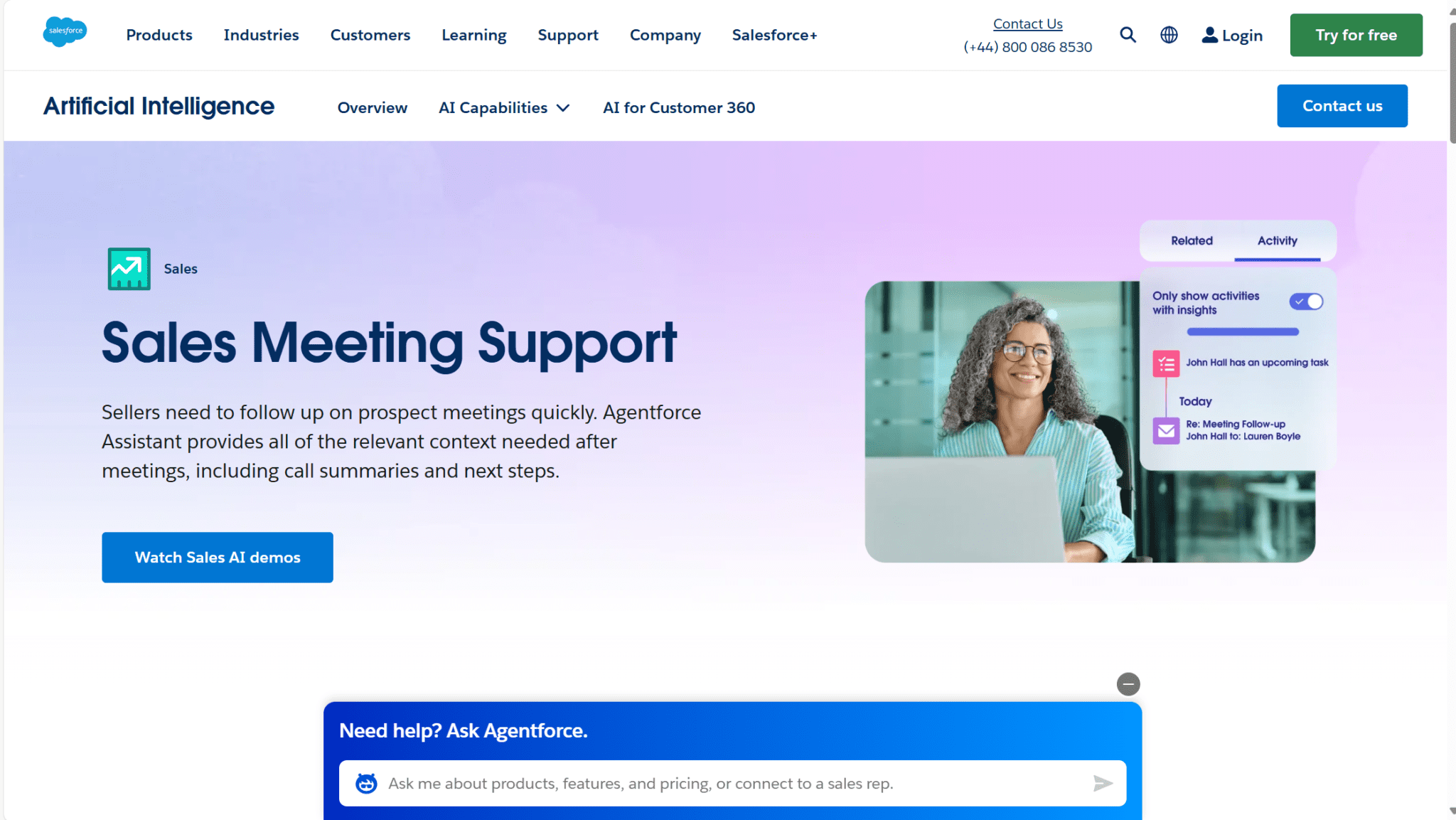
Gong vs Salesforce: 12 Factors to Consider While Choosing the Best AI Notetaker
How do we rank?- We give 2 points to a platform once it is the clear winner or when the capability is equally met by the other.
- We give 1 point when the capability is present, but it’s not a winner.
- We give 0 points when the capability is not present.
Transcription Capabilities
| Gong (26) | Salesforce (20) | |
|---|---|---|
| Transcriptions included | 🟢 | 🟢 |
| Real-time transcriptions | 🟢 | 🟢 |
| Languages supported | 🟢 +70 | 🟠 14 |
| Dialects supported | 🟢 | 🟢 (English and French) |
| Filler word removal | 🟢 | 🟢 |
| Speaker recognition | 🟢 | 🟢 |
| Speaker names | 🟢 | 🟢 |
| Transcribe video/audio uploads | 🟢 | 🔴 |
| Export transcripts | 🟢 | 🟢 |
| Clips from transcript | 🟢 | 🟢 |
| Custom vocabulary | 🟢 | 🟢 |
| Full-Transcript search | 🟢 | 🟢 |
| Edit transcription | 🟢 | 🔴 |
Real-time Transcriptions
Both platforms offer real-time transcription capabilities, enabling users to follow conversations live as they happen. This is especially valuable for sales teams who want to quickly reference what was said without waiting for a post-call summary.
There is a key difference though: Gong offers this natively, while Salesforce’s “Service Cloud Voice” is provided by Amazon Transcribe. The automation is still built-in to the platform, but it’s not as flexible as a custom-built feature.
Languages Supported
Gong supports transcription in over 70 languages, offering strong support for international teams and multilingual sales environments.
Salesforce, by contrast, supports just 14 languages, placing it in a secondary tier in terms of linguistic versatility. While Salesforce can still handle the basics well, Gong is the better fit for teams calling globally or in non-English contexts.
Dialects Supported
Both tools support dialects, but Gong offers broader coverage here as well. Salesforce currently lists dialect support primarily for English and French, whereas Gong includes wider dialect recognition that contributes to more accurate transcriptions across regional accents and local speech variations. This subtle difference may impact accuracy, particularly for teams working in areas with strong dialectical diversity.
Transcribe Video/Audio Uploads
Gong allows users to upload and transcribe external video and audio files, which is incredibly useful for calls held outside the platform, training materials, or inbound recordings.
Salesforce, on the other hand, does not currently support this feature, limiting its versatility in handling content beyond native meeting recordings. This is one of many seemingly basic features that Salesforce doesn’t have.
Clips from Transcript
Both tools also allow users to create clips directly from transcripts, a valuable feature for highlighting key moments in sales calls. These clips can be used in coaching sessions, shared with stakeholders, or added to follow-up materials to reinforce critical points.
Custom Vocabulary
Gong and Salesforce each support custom vocabulary, allowing sales teams to train the transcription engine on their own industry-specific terms, acronyms, or product names. This boosts transcription accuracy significantly, especially in technical or jargon-heavy conversations.
Edit Transcription
Gong allows users to edit transcriptions manually, offering more control for teams that want to fine-tune the final output.
Salesforce currently does not offer manual transcription editing, which may be a limitation for teams requiring more precise or polished records.
Recording Capabilities
| Gong (18) | Salesforce (7) | |
|---|---|---|
| Video platforms | 🟢 Zoom, MS Teams, Google Meet, and more | 🟢 Zoom, MS Teams, Google Meet, and more |
| Storage | 🟢 Unlimited | 🟠 Limited |
| Records video | 🟢 | 🔴 |
| Concurrent meetings | 🔴 | 🔴 |
| Download recordings | 🟢 | 🔴 |
| Capture slides | 🟢 | 🔴 |
| Viewing analytics | 🟢 | 🟢 |
| Integrated Calendar | 🟢 | 🟢 |
| Recording Editing | 🟢 | 🔴 |
| Reels | 🟢 | 🔴 |
| Custom Bot Avatar | 🔴 | 🔴 |
Storage
Gong offers unlimited storage for meeting recordings, making it ideal for teams with high call volumes or those who want to keep historical conversations for compliance, coaching, or long-term analysis.
Salesforce, on the other hand, provides limited storage, which may require users to manually manage old recordings or upgrade storage tiers over time. Another thing to note is that Salesforce doesn’t provide meeting-specific storage. Your limits are tied up with your entire CRM storage.
Records Video
Gong records both audio and video, giving users a full playback experience that includes facial expressions, screen shares, and non-verbal cues—critical elements in high-stakes sales conversations.
Salesforce, however, currently does not support video recording, limiting users to audio-only playback and missing out on visual context. This is a big drawback for teams that value the visual aspect of virtual meetings.
Concurrent Meetings
Neither Gong nor Salesforce currently supports recording multiple meetings at the same time (concurrent meetings). This may present challenges for larger teams running simultaneous calls, particularly in high-volume outbound or SDR environments.
If you’re regularly double-booked, Gong alternatives like tl;dv can record and analyze multiple sales calls at once.
Download Recordings
Gong allows users to download recordings for offline access, archiving, or sharing outside of the platform. Salesforce, by contrast, does not offer download functionality, which can be a drawback for teams that need to store data internally or share meeting content with external stakeholders.
Capture Slides
One standout feature of Gong is its ability to automatically detect and capture slides shared during a meeting. This is useful for reproducing key visual content during review or coaching sessions.
Salesforce currently lacks this feature, meaning slide context can be missed unless manually documented elsewhere.
Viewing Analytics
Both Gong and Salesforce provide analytics on meeting views, giving insight into who’s watching what and when. This can be especially helpful for gauging stakeholder engagement post-meeting, tracking internal coaching adoption, or identifying which clips are most valuable to teams.
Recording Editing
Gong offers in-platform recording editing, allowing users to trim, clean up, or isolate key segments from longer calls.
Salesforce lacks editing tools, meaning any desired tweaks to recordings would need to be done externally, adding friction to the content refinement process.
Reels
Gong includes Reels, a feature that lets users create highlight compilations from multiple calls or key moments. This is perfect for coaching, onboarding, or sharing best practices.
Salesforce does not support reels, and lacks an equivalent feature, putting it behind Gong in post-call content creation.
Custom Bot Avatar
Neither platform currently offers a custom bot avatar to represent the meeting assistant. This is a minor aesthetic feature, but one that some platforms use for branding or personalization purposes.
Conversation Intelligence Capabilities
| Gong (16) | Salesforce (14) | |
|---|---|---|
| Single Meeting AI Insights | 🟢 | 🟢 |
| Multi Meeting AI Insights | 🟢 | 🟢 |
| Keyword tracking | 🟢 | 🟢 |
| Sentiment Analysis | 🟢 | 🔴 Only for surveys |
| Key Topic detection | 🟢 | 🟢 |
| Speech Analytics | 🟢 | 🟢 |
| Action item detection | 🟢 | 🟢 |
| Question detection | 🟢 | 🟢 |
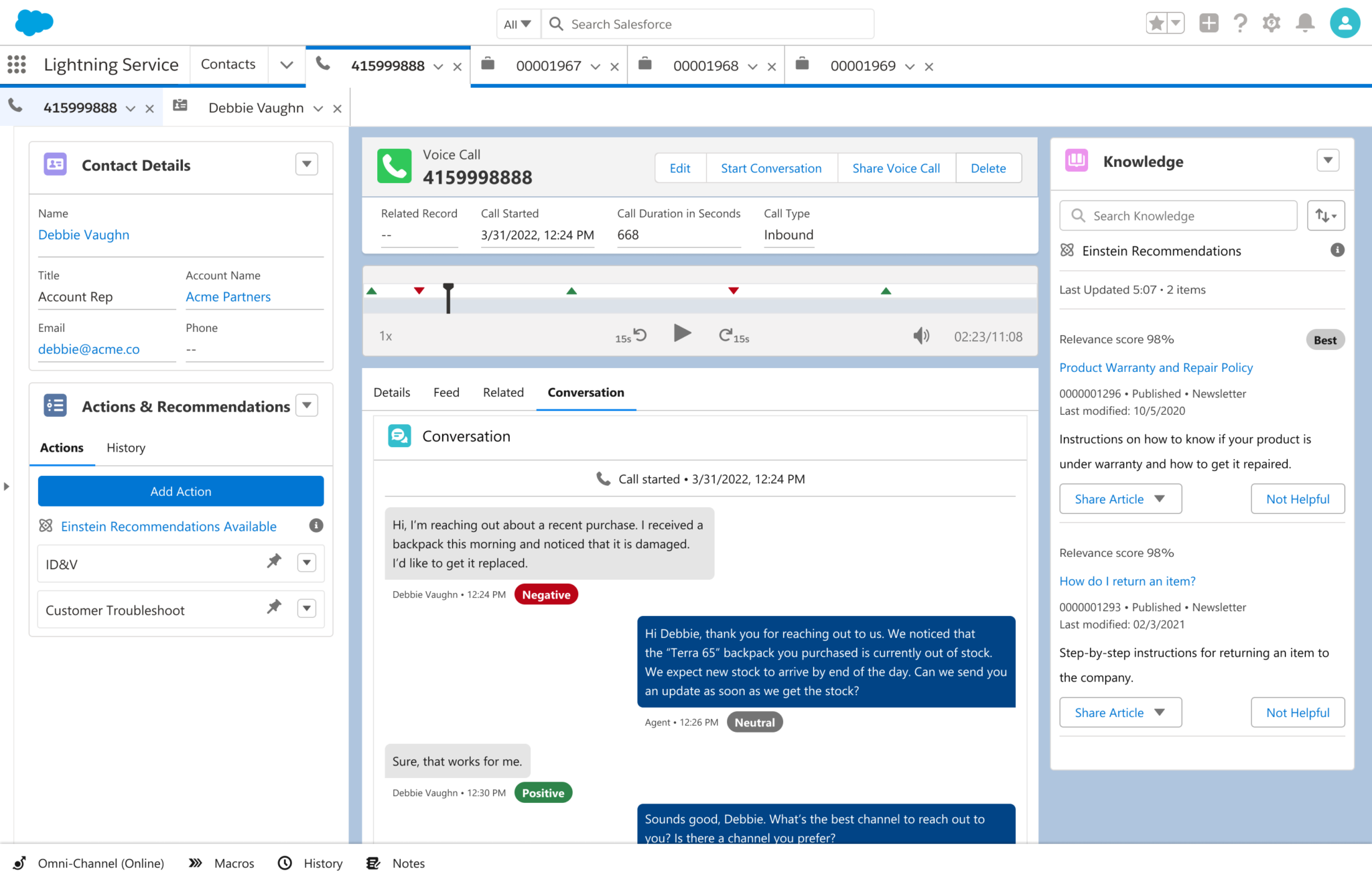
Multi Meeting AI Insights
Gong and Salesforce also both offer AI insights across multiple meetings, enabling pattern detection over time. This is valuable for spotting coaching opportunities, tracking deal momentum, and understanding team-wide trends. Whether you’re analyzing one rep or a full sales cycle, both platforms help zoom out for broader insights.
Sentiment Analysis
Here’s where the two tools diverge. Gong includes sentiment analysis as part of its conversational intelligence suite, offering deeper emotional context behind words. This helps teams understand tone, enthusiasm, hesitation, and overall buyer engagement.
Salesforce, on the other hand, only offers sentiment analysis in post-meeting surveys, not within actual conversations. That means less contextual emotional data from the call itself. Without video recording, it’s difficult for Salesforce to accurately analyze sentiment in the first place.
Speech Analytics
Gong and Salesforce both include speech analytics, which analyze speaking patterns like pace, interruptions, and talk-to-listen ratios. These metrics are especially useful in sales coaching and improving overall communication dynamics.
Automation & Integration Capabilities
| Gong (10) | Salesforce (8) | |
|---|---|---|
| CRM Integrations | 🟢 | 🟢 |
| Email Integrations | 🟢 | 🟢 |
| Zapier Integrations | 🟢 | 🟢 |
| Post-Meeting summary email | 🟢 | 🔴 |
| Schedule Reports | 🟢 | 🟢 |
CRM Integrations
Both Gong and Salesforce integrate deeply with major CRMs—including each other. Gong connects natively to Salesforce, allowing for automatic syncing of call data, notes, and deal insights directly into your CRM. Meanwhile, Salesforce being a CRM at its core, naturally serves as the foundational integration hub, pulling in call data from tools like Gong or its own Einstein Conversation Insights module. Sales teams also benefit from utilizing a Salesforce email plugin to integrate email threads directly into the CRM, enabling a more unified communication and data trail.
This is where Salesforce takes the lead. It’s a lot easier to automate workflows when everything takes place on the same platform.
Zapier Integrations
Zapier integrations are available on both platforms, allowing teams to connect Gong or Salesforce to thousands of other apps and automate workflows. Whether you’re logging data to a spreadsheet, pinging Slack after a call, or triggering follow-up tasks, Zapier opens up flexible automation opportunities.
Post-Meeting Summary Email
Here’s a notable difference: Gong offers automated post-meeting summary emails, sending out key highlights, action items, and insights to attendees or managers. This helps ensure alignment and quick follow-ups.
Salesforce does not offer this natively, which may require a more manual or custom setup using workflows or external tools.
Schedule Reports
Both Gong and Salesforce allow users to schedule recurring reports, making it easy for sales managers to track rep performance, conversation metrics, and pipeline progress. This also allows users to filter for specific topics or phrases, such as competitor mentions, price objections, or feature requests. Whether it’s daily, weekly, or monthly, users can stay informed without needing to dig for data.
Note-taking Capabilities
| Gong (14) | Salesforce (14) | |
|---|---|---|
| AI Notes | 🟢 | 🟢 |
| Manual notes during calls | 🟢 | 🟢 |
| Tag people in notes | 🟢 | 🟢 |
| Assign tasks | 🟢 | 🟢 |
| AI Tags / Bookmarks | 🟢 | 🟢 |
| Comments | 🟢 | 🟢 with Chatter |
| Custom Meeting Templates | 🟢 | 🟢 |
AI Notes
Both Gong and Salesforce offer AI-generated meeting notes, helping teams skip the manual recap and focus directly on action. Gong uses AI to pull out relevant insights, summarize conversations, and highlight what matters most, while Salesforce taps into Einstein AI to extract similar details, especially when paired with Einstein Conversation Insights.
Tag People in Notes
You can @mention colleagues in notes on both Gong and Salesforce, making collaboration smoother. Gong supports tagging team members to draw attention to insights or follow-ups, while Salesforce achieves this using Chatter, its internal communication layer.
Assign Tasks
Gong and Salesforce both allow users to assign tasks directly from notes, whether that’s follow-up emails, customer check-ins, or internal actions. Gong excels in sales-focused task assignment, while Salesforce’s broader CRM framework makes it more flexible across departments.
Comments
Commenting is a strong collaboration feature in both tools. Gong allows inline comments on transcripts and notes, while Salesforce uses Chatter to enable comments, updates, and discussions around calls or records.
Custom Meeting Templates
Both Gong and Salesforce support custom meeting templates. In Gong, this can help reps structure their call reviews or sales training sessions. In Salesforce, templates are integrated into the broader CRM flow, aligning meeting formats with specific deal stages, customer types, or playbooks.
Security Capabilities
| Gong (8) | Salesforce (16) | |
|---|---|---|
| Data retention | 🟢 | 🟢 Customizable |
| SOC2 Compliant | 🟢 | 🟢 |
| SAML-based SSO | 🟢 | 🟢 |
| GDPR Compliant | 🟠 Partial | 🟢 |
| EU AI Act Compliant | 🔴 No due to Sentiment Analysis | 🟢 |
| Uses your data to train AI | 🟠 Yes, its opt-in | 🟢 (No, your data is kept private) |
| Private storage | 🔴 not disclosed | 🟢 |
| Anonymized sensitive data sent to LLMs | 🔴 not disclosed | 🟢 (optional) |
| Meeting data chunking and randomizing | 🔴 not disclosed | 🔴 not disclosed |
| BAA with LLM providers | 🔴 not disclosed | 🔴 not disclosed |
| 0-day data retention policy with vendors | 🔴 not disclosed | 🔴 not disclosed |
Data Retention
Both Gong and Salesforce support customizable data retention policies, giving organizations control over how long meeting data is stored. Salesforce’s flexibility is a bit broader here, with admin-level configuration available to meet strict compliance needs.
GDPR Compliant
Salesforce is fully GDPR compliant, while Gong is only partially compliant due to how it processes certain AI-driven features. This could be important for EU-based companies or those with GDPR obligations.
EU AI Act Compliant
A notable distinction: Salesforce is compliant with the EU AI Act, while Gong is not. This is mainly because of Gong’s sentiment analysis feature which falls outside of current compliance parameters. For organizations operating in or selling to the EU, this could be a key deciding factor.
Uses Your Data to Train AI
Gong allows opt-in usage of your data to train its AI models, giving customers some choice, but this could raise concerns for privacy-sensitive sectors.
Salesforce, on the other hand, does not use customer data to train its AI, ensuring complete data isolation and privacy.
Private Storage
Salesforce offers private storage options, while Gong has not disclosed whether such options are available. For enterprise users with strict hosting requirements, Salesforce provides a much more transparent approach.
Anonymized Sensitive Data Sent to LLMs
Salesforce allows optional anonymized data to be sent to large language models (LLMs), putting data governance in the hands of the user. This ensures sensitive data is kept private. Gong hasn’t disclosed whether it sends sensitive data to LLMs or how it handles anonymization, marking it as a riskier pick between the two.
0-Day Data Retention Policy with Vendors
Neither provider has disclosed whether they have a zero-day data retention policy in place with vendors. This would prevent third parties from retaining your meeting data beyond its immediate processing window. As neither tool specifies this, you’d need to reach out to their respective sales teams to find out.
Coaching Capabilities
| Gong (8) | Salesforce (8) | |
|---|---|---|
| Scorecards | 🟢 | 🟢 |
| Custom Playbooks | 🟢 | 🟢 |
| Template Playbooks | 🟢 | 🟢 |
| Objection Handling | 🟢 | 🟢 |

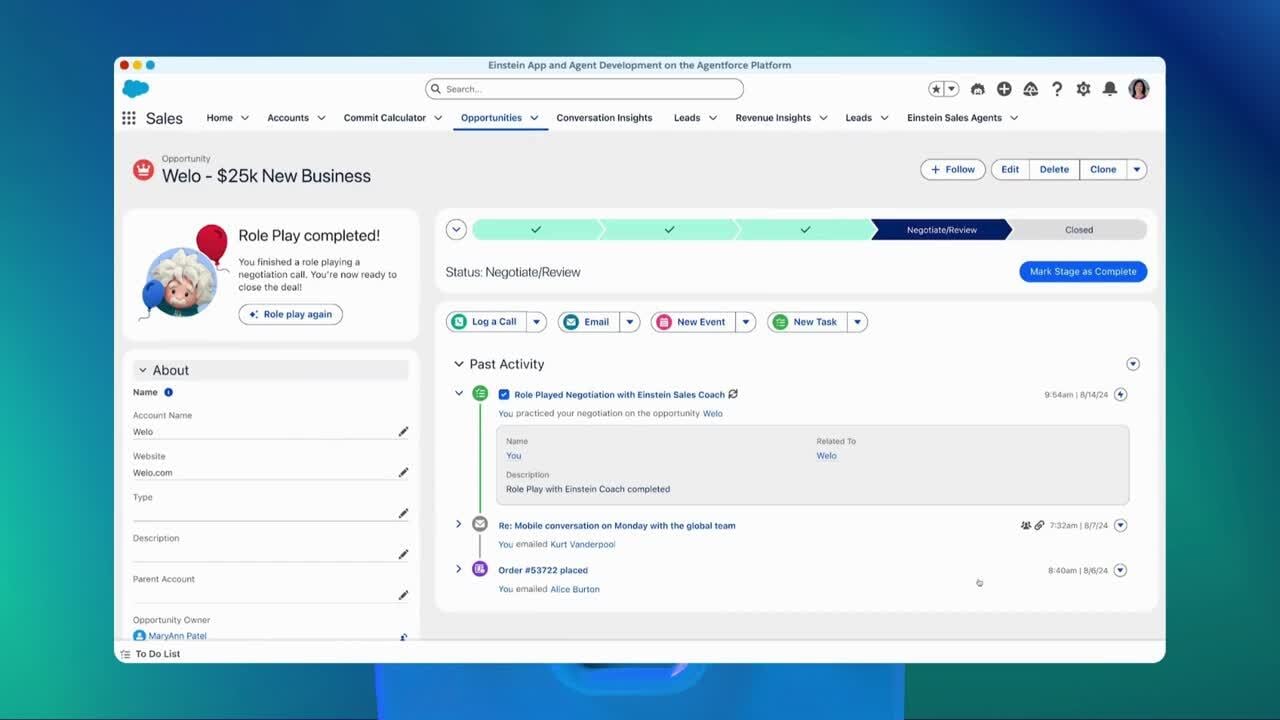
Both Gong and Salesforce draw level when it comes to coaching capabilities. They both provide AI scorecards, a variety of playbooks (including customizable templates), and AI objection handling tips. This makes it simple to turn your conversations into opportunities to learn.
While all features are present in both tools, Gong still has the slight advantage as this is their specialty. Its primary purpose is to capture and analyze every sales interaction, and provide sales reps with personalized recommendations to enhance their performance based on the behaviors of top performers.
Gong stands out in objection handling by providing sales teams with actionable, data-driven insights. Through its conversation intelligence platform, Gong analyzes sales calls to identify patterns and effective techniques, such as pausing after objections, clarifying with questions, and validating concerns. These insights help sales reps refine their approaches during challenging interactions, leading to more successful outcomes.
While Gong integrates seamlessly with CRM systems like Salesforce to enrich sales data and workflows, Salesforce itself offers a comprehensive, all-in-one platform. As a leading CRM solution, Salesforce centralizes customer data, sales processes, and analytics, eliminating the need for additional integrations to manage core business functions. This unified approach simplifies operations, enhances data accuracy, and provides a cohesive user experience.
Admin Capabilities
| Gong (4) | Salesforce (4) | |
|---|---|---|
| Apply auto-record of all meetings in the team members’ calendar | 🟢 | 🔴 |
| Apply auto-share of meetings recorded by team members | 🟢 | 🔴 |
| Prevent Deletion | 🔴 | 🟢 |
| Admin rights over all recordings | 🔴 | 🟢 |
Apply Auto-Record of All Meetings in the Team Members’ Calendar
Gong gives admins the ability to automatically record all meetings scheduled on team members’ calendars, making it easy to ensure coverage across the board without requiring manual activation.
Salesforce, on the other hand, does not offer this feature, which may limit visibility across distributed or fast-moving sales teams.
Apply Auto-Share of Meetings Recorded by Team Members
With Gong, admins can automatically share recorded meetings, ensuring key stakeholders or managers always have access to important calls without depending on reps to manually distribute them. Salesforce lacks this functionality, potentially requiring more manual effort and follow-up.
Prevent Deletion
Salesforce provides admins with the ability to prevent deletion of meetings and recordings, a critical feature for maintaining records for compliance or internal review.
Gong does not offer this protection, which could present a risk if recordings are accidentally or intentionally deleted. The rep is able to delete any call they wish and prevent the manager from ever seeing it.
Admin Rights Over All Recordings
Salesforce allows administrators to access and manage all recordings across users, giving them full visibility and control. This centralized oversight can be vital for managing quality and ensuring compliance.
In contrast, Gong does not provide admin-level access to all recordings, potentially limiting control in larger teams or regulated industries.
Organizational Capabilities
| Gong (12) | Salesforce (10) | |
|---|---|---|
| Team Workspaces | 🟢 | 🟢 |
| Meetings Library | 🟢 | 🟢 Asset Library |
| Smart Filters | 🟢 | 🟢 |
| Global Search | 🟢 | 🔴 |
| Search within meetings | 🟢 | 🟢 |
| Folders | 🟢 | 🟢 |
Meetings Library
Gong offers a centralized Meetings Library, making it easy to store, reference, and revisit past conversations. Salesforce provides a similar capability through its Asset Library, where teams can manage recordings and key assets. Though the naming and structure may differ slightly, the core utility remains.
Smart Filters
Both platforms include Smart Filters, empowering users to quickly sort and find relevant meetings based on customizable criteria like participants, topics, or keywords. This helps teams locate high-value conversations faster and streamline workflows.
Global Search
Gong provides a powerful Global Search functionality, enabling users to search across all meetings, transcripts, notes, and shared content. This makes finding specific meeting moments simple.
Salesforce, however, lacks this universal search, which may slow down content retrieval across a larger volume of conversations. This, again, highlights why Gong is a specialist in this area.
Support Capabilities
| Gong (2) | Salesforce (2) | |
|---|---|---|
| Support in Free Plan | 🔴 Not applicable as no free plan | 🔴 Not applicable as no free plan |
| Priority Support | 🟢 | 🟢 |
Support in Free Plan
Neither Gong nor Salesforce offers a free plan, which means support is not available without a paid subscription. Both platforms are designed for enterprise use and operate on a pricing model that assumes onboarding and support will occur within the context of a paid engagement.
Priority Support
Both Gong and Salesforce offer Priority Support as part of their enterprise-tier packages. This typically includes faster response times, dedicated customer success representatives, and access to premium resources, ensuring that customers receive timely and efficient support when issues arise.
Revenue Intelligence Capabilities
| Gong (4) | Salesforce (4) | |
|---|---|---|
| Forecasting | 🟢 | 🟢 |
| Deal execution | 🟢 | 🟢 |



Forecasting
Gong leverages AI-driven analytics to enhance sales forecasting by analyzing data from sales interactions, including meetings, calls, and emails. By capturing and processing this conversational data, Gong provides insights into deal health, pipeline status, and potential revenue outcomes. This approach allows sales teams to base their forecasts on real-time customer interactions rather than solely on CRM data.
Salesforce, as a comprehensive CRM platform, offers powerful forecasting tools such as Collaborative Forecasts and Pipeline Inspection. These features enable sales teams to project future sales based on historical data and current pipeline information. While Salesforce’s forecasting is deeply integrated within its CRM ecosystem, it may rely more heavily on manually entered data and predefined metrics, which can sometimes lead to less dynamic forecasting compared to AI-enhanced methods.
Gong’s strength lies in its ability to incorporate real-time conversational data into forecasting, whereas Salesforce offers a structured, CRM-centric approach that benefits from its deep integration within the broader Salesforce ecosystem. For organizations prioritizing insights derived from direct customer interactions, Gong may offer an advantage. However, for those seeking a unified system within their existing CRM, Salesforce’s forecasting tools provide a cohesive solution.
Deal Execution
Gong offers a Deal Execution feature that provides visibility into all pipeline deals by analyzing sales conversations and activities. It helps sales leaders understand deal progress, identify risks, and coach reps effectively. By tracking key deal indicators and comparing them against successful patterns, Gong enables proactive management of deals to prevent slippage and enhance win rates.
Salesforce facilitates deal execution through its CRM capabilities, allowing tracking of deal stages, management of contacts, and scheduling of follow-ups. While it offers tools for managing the sales process, it may not provide the same level of conversational insight as Gong. However, Salesforce’s extensive customization options and integrations can be leveraged to build a tailored deal execution process that aligns with an organization’s specific needs.
Organizations focused on leveraging conversation analytics for deal execution may find Gong more aligned with their needs, whereas those seeking a customizable CRM-centric approach might prefer Salesforce.
Who Is It For?
| Gong (6) | Salesforce (5) | |
|---|---|---|
| G2 Rating | 🟢 4.8 | 🔴 4.5 |
| Ease of set up | 🟠 Hard, requires a lot of technical input and set up | 🟠 Hard, confusing pricing structure, highly complex platform |
| Localized platform | 🟠 Limited, website appears to have 3 | 🟢 11+ |
| Best suited for whom | 🟢 Large enterprise | 🟢 Large enterprise |
Both Gong and Salesforce are built for large enterprises, but both tackle a slightly different niche. Where Gong is laser-focused on conversational intelligence from sales calls, Salesforce is a comprehensive CRM platform with conversational intelligence features added in. This means that the two are not direct competitors and, if the budget allows, they may actually work better in conjunction with one another.
As for G2 rating, Gong comes out on top with 4.8/5 compared to Salesforce’s 4.5. Neither of them are particularly easy to get started with. They’re both big, complex tools with lots of bells and whistles and no free plan, meaning there’s a big cost up-front and a steep learning curve regardless of which tool you choose to use.
In terms of global support, Salesforce is a standout winner, offering a localized platform in more than 11 languages! This makes the UI more optimized for global teams than Gong’s UI, which seems to be only localized in 3 languages.
Verdict: Gong vs Salesforce – Which One Is the Best?
| Gong | Salesforce | |
|---|---|---|
| Transcription | 26 🟢 | 20 |
| Recording | 18 🟢 | 7 |
| Conversational Intelligence | 16 🟢 | 14 |
| Automation & Integrations | 10 🟢 | 8 |
| Note-taking | 14 | 14 |
| Security | 8 | 16 🟢 |
| Coaching | 8 | 8 |
| Admin | 4 | 4 |
| Organizational | 12 🟢 | 10 |
| Support | 2 | 2 |
| Revenue Intelligence | 4 | 4 |
| Other | 6 🟢 | 5 |
| Total | 128 🟢 | 112 |
This Gong vs Salesforce face-off ends with a clear, but somewhat expected, winner. Gong pulls ahead with 128 points, outpacing Salesforce’s 112, thanks to its standout strengths in transcription, recording, conversational intelligence, automation & integrations, and organizational features. While the gap isn’t massive, it highlights Gong’s laser focus on uncovering high-impact insights directly from conversations. It’s a true powerhouse for teams who live and breathe meetings.
If your organization’s priority is turning sales conversations into actionable intelligence, Gong is the specialist. It excels at capturing, analyzing, and leveraging meeting content to fuel pipeline visibility, coach reps, and optimize deal execution. With strong support for major video platforms, rich note-taking capabilities, and advanced AI insights, Gong is built from the ground up to help revenue teams actually use the goldmine of data hidden inside their calls.
That said, Salesforce holds its ground in several critical areas—particularly in security, where it dominates with enterprise-grade compliance, customizable data retention, and more transparency around AI usage. It also brings a comprehensive, tried-and-tested CRM foundation to the table, with forecasting, pipeline management, and customer data all housed under one roof. Its conversational intelligence features are solid, but clearly an add-on to its core CRM DNA and not a dedicated focus like Gong’s.
Ultimately, this isn’t a matter of choosing one over the other. Gong and Salesforce aren’t direct competitors—they’re built for different layers of the sales tech stack, and when used together, they supercharge each other. Gong makes Salesforce data richer by pulling in context from real customer conversations, while Salesforce provides the infrastructure and operational oversight that Gong doesn’t aim to replace.
Both platforms are designed for enterprise sales teams, and neither offers a free plan—so this is a serious investment. But if you can afford to pair them, you’ll get the best of both worlds: Gong’s intelligence and Salesforce’s orchestration. For teams aiming to scale revenue with precision, insight, and control, this combo might just be the ultimate power couple. Alternatively, tl;dv offers many of the same features as Gong at a much more affordable price point, and it integrates just as smoothly with Salesforce. Check out our tl;dv vs Gong comparison for a breakdown of the specifics.
